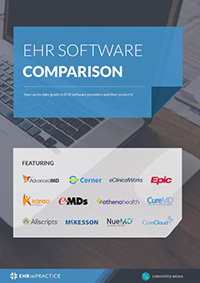Top ophthalmology EHRs for your selection shortlist
Ophthalmology and optometry present a unique set of circumstances since their EHR needs center on diagnostic procedures; measures and data cannot be adequately served by a general EHR. In the emerging specialty market of ophthalmology EHR systems, the following three products reviewed here represent the emerging leaders among specific ophthalmology EHR systems.
Discussions surrounding the adoption of EHR are mostly dominated by applications suited for traditional medical practices, however as the market has matured and adoption becomes more pervasive, specialty-oriented products are gaining traction. This seems logical, as ophthalmologists, just as their peers in other medical fields, are bound by the same meaningful use regulations and have the same incentives beyond the regulatory mandates to make their practice more efficient with technology.
What is an ophthalmology EHR?
An ophthalmology electronic health record (EHR) system is a healthcare software uniquely designed to meet the needs and features of ophthalmology practice including specialist patient templates to save time for physicians between patients. There are also increased compliance and functionality using a specialist ophthalmology EHR software allowing interoperability between healthcare providers for patients who are being seen across multiple disciplines.
1. CureMD
CureMD offers web-based certified EHR, practice management, patient portal and revenue cycle management. CureMD’s system supports built-in templates specific to ophthalmology that can be automated to suit workflow.
Find the best software for your practice with this comprehensive ophthalmology EHR buyers' guide
In addition to its standard EHR functionalities, CureMD also allows for integration with ophthalmology diagnostic tools adding digital images and diagnostic testing results directly to patient records. One of the the system's USPs rests in its data management and analysis capabilities. This allows it to aggregate information gathered from the EHR, practice management and electronic billing for analysis, trending and reporting. Some users expressed concerns about CureMD’s iPad platform being overly basic and a lack of support for Mac OS.
2. EMA Ophthalmology
Modernizing Medicine’s Electronic Medical Assistant® (EMA™) for ophthalmology is an iPad and cloud-based EHR and practice management system. Besides its EHR functionality, the system supports quality of care reporting and outcome-based reimbursement. This function is supported by technology able to handle coding related to value based payment measures, therefore, enabling quality reporting.
In addition to these features, which appear to be the foundation for EMA’s brand position, the system can also remember a provider’s specific requirements through an adaptive learning engine. These features appear to have been embraced by users. This upside has been coupled with only minor concerns from users who primarily express minor problems in the system’s functionality and some customer care related issues regarding billing.
GET EHR RESEARCH & KNOWLEDGE RIGHT TO YOUR INBOX
Covering the key issues faced by businesses selecting and implementing EHR.
3. Medflow
Medflow offers an EHR system available as either a standalone EHR or as a complete EHR and practice management suite for patient management billing and patient scheduling.
Medflow’s value is based on its ability to provide built-in templates including retina scans and surgery, cataracts, glaucoma, digital drawings, eye measurements, and LASIK procedures. The image workflow management module functions easily within image-intensive ophthalmology practices. The integrated patient portal enables patients to complete intake forms online, saving time and eliminating paperwork.
Although it has not been on the market as long as other products, Medflow’s product offering has proven that its main selling points are its reliability and its ability to integrate seamlessly into practice workflow.
4. EyeMD EMR
EyeMD was developed by ophthalmologists for ophthalmologists, and as such offers numerous specific features, including built-in DICOM imaging and integration with the IRIS Registry to assist with both patient care and clinical discovery. EyeMD also offers optical inventory and point of sale solutions which can integrate with the EMR.
EyeMD's solution is reviewed well by users - in the latest ASOA (American Society of Ophthalmic Administrators) EHR User Satisfaction Survey, the system ranked well for ease of use, imaging features, documenting information and support and training. More respondents said they would recommend EyeMD than any other system.
5. Nextech Ophthalmology
Nextech's ophthalmology-specific IntelliChartPRO emphasizes an intuitive UX and streamlined charting workflows. It was named the #1 EHR Collaborator with the most registered practices through the American Academy of Ophthalmology's IRIS registry.
The software integrates easily with diagnostic devices, and contains strong imaging and drawing features. Nextech also offers integrated practice management and revenue management features, making it a good choice for practices looking to implement a single system across all departments.
Based on this brief review of the principal players in the ophthalmology EHR market the overriding theme to be taken away here is that the current landscape appears to be competitive with capable players who deliver reliable products. As such, vendors may feel the pressure to innovate and further improve their offerings to carve out a safe space in this market.
Free white paper

EHR Software Comparison
A hand-picked comparison of leading EHR software systems

Featured white papers
Related articles
-

Top oncology EHRs to kickstart your selection shortlist
Learn about some of the leading oncology EHR systems on the market including CureMD, ARIA Oncolog...
-

Allscripts acquires Practice Fusion: what this means for users
What effect will Allscripts' Practice Fusion acquisition have on the EHR market
-

Five of the best EHR systems for cardiologists
Top cardiology EHR systems to kick off your selection shortlist




